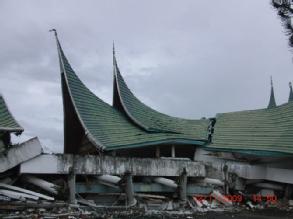School of Engineering News
Successful UK-Indonesia bidding to reduce seismic risk in West Sumatra
Earthquakes in Indonesia recurrently produce huge economic and human losses, many of which would be preventable with a better understanding of seismic risk. Particularly in West Sumatra, much of the risk arises from vulnerable buildings prone to collapse (Fig. 1). In recent years, Information and Communications Technologies (ICTs) have been used to assess vulnerable buildings and to calculate seismic risk more accurately, but more work is needed to harness ICTs’ full potential. A successful EPSRC project led by Dr Reyes Garcia will develop an innovative, rapid and efficient framework for multi-hazard seismic risk assessment with ICT ecosystems to enhance West Sumatra's disaster preparedness, using Padang city as a pilot case study. The project is expected to help West Sumatra’s Regional Disaster Management Agency (BPBD) efforts on disaster preparedness to reduce potential losses in future earthquakes.

Fig. 1. Vulnerable building collapse during 2009 Padang earthquake
The project synergises complementary expertise from three world-class institutions in Indonesia and the UK: Universitas Bung Hatta (UBH), Institut Teknologi Bandung (ITB) and University of Warwick (UW).
Krishna Pribadi, Professor of Disaster Mitigation and Co-I at ITB, comments: “As Indonesia strives to reduce seismic risk, here, at the Disaster Mitigation Research Center of ITB, we are incredibly excited to share our expertise with other universities in Indonesia and abroad”.
Suhono Harso Supangkat, Professor of Information Technology at ITB and Co-I, also comments: “We are developing cloud computing architectures for early detection of disasters in urban areas and therefore this project is an excellent opportunity to apply our technology in the field.” Co-I Dr I Gusti Bagus Baskara Nugraha, also from ITB, adds: “We are delighted that our ICT ecosystems can be adapted to increase community preparedness during earthquakes and help refine risk calculations in West Sumatra.”
Dr Rini Mulyani (Co-I) at UBH indicates: “after the destructive West Sumatra earthquake in 2009 we started collaborating with the Regional Disaster Management Agency (BPBD) through our ‘Center of Disaster Studies’, and therefore this project is helping us to strengthen and extend our national and international collaborations with top institutions in the world”.
The project will also build on work by Dr Prasanti Widyasih Sarli and Dr Roi Milyardi from ITB. Dr Prasanti Widyasih Sarli comments,”In Indonesia, a major challenge lies in assessing the vulnerability of typical non-engineered houses. Our AI technology can estimate the vulnerability of such structures and we are thrilled to apply it in this collaboration.”
Lead UK researcher at Warwick, Dr Reyes Garcia, explains: “The three partner universities have been working for years on different areas of seismic risk but our research was fragmented. We are delighted to work with UBH and ITB as our complementary expertise in civil engineering and ICT will allow West Sumatra to reduce economic losses and negative social impacts of future earthquakes.”
The project also includes reciprocal visits between Indonesia and the UK, as well as capacity building activities in both countries. The team is complemented by Salsabila Quraini Rahmi, Zufrimar, and Rita Anggraini (Universitas Bung Hatta).
Ends
Notes to editors:
1. The researchers involved are:
· Reyes Garcia, (University of Warwick);
· Rini Mulyani (Universitas Bung Hatta)
· Krishna Pribadi, Suhono Harso Supangkat, I Gusti Bagus Baskara Nugraha, Prasanti Widyasih Sarli, and Dr Roi Milyardi (Institut Teknologi Bandung);
· Saeed Pourfalah (Concrete4Change Ltd)
· Research Assistants: Salsabila Quraini Rahmi, Zufrimar, and Rita Anggraini (Universitas Bung Hatta)
